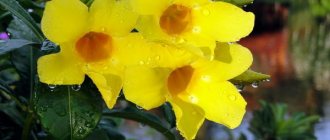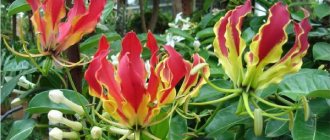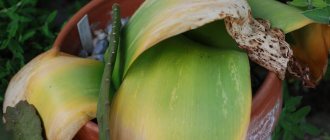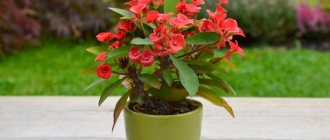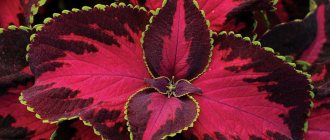As Guernia grows, it forms many fleshy branched stems from 5 cm to 1.5 m in length. The shoots can be ampelous, drooping or erect; in most species they are colored light green and have several wide edges. During flowering, small star-shaped inflorescences with sepals of a deep burgundy or pale yellow hue, decorated with stripes, spots, speckles or strokes, appear on the stems.
Also be sure to pay attention to the stephanotis plant.
| Low growth rate. |
| Blooms in summer. |
| The plant is easy to grow. |
| Perennial cactus. |
Guernia: care at home. Briefly
| Temperature | In spring and summer – about +25°С, in autumn and winter (during rest) – about +15°С. |
| Air humidity | Moderate or low, too humid air can provoke the appearance of rot and disease. |
| Lighting | Bright, diffused. During midday hours, shading from direct sunlight is required. |
| Watering | In spring and summer - moderate with short periods of soil drying, in winter - scanty. |
| Priming | Loose, slightly alkaline. You can prepare it yourself: from sand, garden and leaf soil, peat and charcoal in a ratio of 3:2:2:2:1. |
| Feeding and fertilizer | Guernia at home does not require frequent fertilization; it is fed once a month during the period of active growth with a product for succulents. |
| Replanting Guernia | Annually for young plants, every 2-3 years for older specimens. |
| Reproduction | Stem cuttings or seeds. |
| Features of cultivation | The plant needs a winter dormancy period. |
Care
Guernia is classified as an easy-to-care plant; even novice gardeners can grow it. The requirements of this flower are minimal; if you carry out proper care at home, then problems will bypass you.
Lighting
If you decide to grow a flower on a windowsill, it is better to place it on the east or west side. It is advisable to have natural light in the morning and afternoon. Guernia loves the bright light of the sun. But after lunch, this light can have an adverse effect, so it is worth moving the plant into the shade at this time.
If there is little lighting, the shoots will stretch out and cease to be decorative. Therefore, in the winter season, when the length of daylight is minimal, it is worth using phytolamps.
Location
It is worth noting that Guernia does not like to change its habitat. It should always be illuminated from the same angle.
If you rotate the plant or move it to another location, this may show in its appearance.
Temperature
In the warm season, the plant can grow on a balcony or in a summer cottage. The optimal temperature for this period is 23-27 degrees.
Watering
In summer and spring, guernia should be watered carefully, only after the dried layer of soil is equal to half of the entire tub. Wetting the soil too much is unsafe for the plant; it can lead to acidification of the soil.
The consequence of improper watering can be rotting of the stems or soil. This is fraught with the death of the flower. In winter, the plant is not watered.
Humidity
If the air in the room is dry, this will only benefit the plant. It does not require additional methods of moisturizing.
The soil
The soil for planting Guernia should be sufficiently porous. Most often in stores they buy a mixture for succulents. However, we recommend adding some fine gravel to this soil mixture.
The pot should be low and wide. This is due to the weak development of the root system of the flower. The plant grows very quickly over the entire surface of the container.
Top dressing
It is necessary to feed the plant from the beginning of active growth until the end of summer. Do this once a month. Use store-bought fertilizers for succulents. In winter, fertilizing at home is not necessary.
Caring for Guernia at home. Details
Guernia flowering
Guernia at home usually blooms in summer. At this time, single star-shaped flowers appear on the stems, collected in inflorescences of 2-8 pieces.
The guernia flower is formed by sepals bent outward and fused together, which at their bases converge into a wide tube. The color of the flowers is usually dark burgundy or pale yellow; the sepals can be decorated with bright stripes, strokes, speckles, spots, etc. The flowering plant emits an unpleasant smell of rotting meat.
Temperature
The plant is thermophilic; during the period of active growth it feels especially comfortable at an air temperature of +22-+27°C. Guernia can tolerate even more intense heat, but its shoots become wrinkled, and its flowers quickly wither and fall off.
Guernia requires a cool winter to set flower buds.
The air temperature in the room where the plant rests in the cold should be +15-+18°C.
Spraying
Guernia feels great at low air humidity, so it does not need additional spraying. This can be done only occasionally for hygienic purposes in order to remove dust and dirt from the shoots; excess moisture should be immediately removed with a napkin or soft cloth.
Lighting
The plant is photophilous; it needs constant bright, but diffused light all year round. However, direct sunlight is “welcome” by Guernia only in the morning and evening hours; the rest of the time it can leave deep burns on the stems.
It is best to place Guernia on an eastern or western windowsill. If you place a pot with a plant on a north window, its stems will stretch due to lack of light, and flowering may not occur at all. Guernias living on southern windows are sure to provide shade from the midday sun.
When caring for a plant, it is important to remember that it “gets used” to a certain lighting angle. It is not recommended to rotate and move it from place to place, otherwise there is a high risk of guernia losing all formed buds.
Watering Guernia
In the spring and summer, the plant is watered moderately, avoiding overwatering and stagnation of moisture in the soil.
The frequency of watering during active growing season is once every 10-15 days. House guernia needs short dry periods. To organize such conditions for it, the substrate is systematically dried by about half between waterings. With the onset of the dormant period, watering is limited to a minimum: the soil is moistened no more than once a month. At the end of the rest period, the soil in the pot with Guernia may become so dry that it will no longer absorb moisture. To “water” the plant in such a situation, you need to immerse the pot in a deep container filled with water for half an hour. Afterwards, the liquid is allowed to drain and the flower is put in place.
The following irrigations are carried out in the traditional way.
Pot for Guernia
The ideal container for the shallow root system of Guernia is a flat and wide pot with a drain hole to remove excess moisture. The roots do not grow very much over the season, so there is no need to choose a pot that is too spacious; its diameter should be only a few centimeters larger than the diameter of the plant’s root system.
Priming
The substrate for growing Guernia must be loose, air- and moisture-permeable, and slightly alkaline.
You can select a suitable soil mixture from industrial options intended for succulents and cacti, or prepare it yourself from river sand (perlite), leaf and clay-turf soil, peat and charcoal (fine gravel). The components of the substrate are taken in the proportion 3:2:2:2:1. Before planting, be sure to pour a thick layer of drainage into the bottom of the pot to prevent stagnation of moisture in the soil.
Feeding and fertilizer
It is recommended to feed Guernia only during the active growing season: once a month, using fertilizers marked “for cacti and succulents.” During the rest period, feeding is completely stopped.
Replanting Guernia
The young plant is replanted annually in the spring months before the formation of inflorescences.
Guernia that has reached a more mature age is transplanted every 2-3 years. It is recommended to combine this procedure with plant renewal: old dry shoots should be completely removed, leaving only young cuttings - they are the ones who will be able to produce the largest number of inflorescences in the new season.
Trimming
Trimming the fleshy stems of guernia is not necessary and even dangerous; this can provoke the development of rot and further death of the plant. If necessary, excess or damaged shoots can be periodically carefully removed entirely.
Rest period
Caring for Guernia at home includes organizing an annual dormant period during the winter months. At this time, the plant is transferred to a cool, well-lit room. Watering in November and February is reduced to a minimum (up to once a month), and in December and January it is stopped completely.
Possible difficulties during cultivation
If there is an excess of moisture and an increase in the concentration of nitrogen in the soil, gardeners may encounter the following problems when growing Guernia rougha:
- root and stem rot - it is impossible to solve the problem; after the first symptoms appear, the plant dies within 2 days;
- Mealybug - removed manually with a cotton swab dipped in a soap solution, then treated with the Aktara insecticide according to the instructions.
Guernia rougha is an interesting variety of succulent. The plant adapts well to any microclimate and is easy to care for. The only requirement is moderate humidity.
Growing Guernia from seeds
The guernia plant at home is propagated by seeds quite rarely, since this process is very painstaking and time-consuming. However, it is quite possible to obtain a new plant using this method; they do it this way: in the spring, the seeds are sown in containers with a peat-sand mixture, sprayed with warm water and covered with polyethylene or glass.
In warm conditions under diffused lighting, seedlings appear in about a month. The greenhouse should be regularly ventilated and protected from drafts so that the seedlings do not rot.
When the plants become stronger, they are planted in individual pots and continue to be cared for as for adult specimens.
What to do after buying a plant
Transporting the flower is not difficult; it is not particularly fragile. It is important to simply protect it from mechanical damage during transportation. In the first days, it is better not to water the flower and put it in the shade. In order for Guernia to adapt to new conditions, the soil should be sprayed with a spray bottle. You should not replant purchased adult Guernia while it is blooming or overwintering.
If the seeds are collected in the current season, then they do not need to be processed. Last year's planting material is soaked in water. Its temperature should be about 30–35 degrees. In such conditions, the seeds are left for a day. When planting seeds, they should not be deepened too much. For seedlings, create comfortable greenhouse conditions by covering the container with glass. They don't sprout quickly. After the seedlings produce their first leaves, they are recommended to be planted in small pots or cups.
Propagation of Guernia by cuttings
Guernia is easily propagated by stem cuttings. The planting material is separated from the mother plant with a sharp knife and left to dry for a couple of days. Prepared cuttings are planted in a well-moistened mixture of sand and peat.
Strong roots appear within 1.5 weeks, after which young plants can be transplanted into individual pots. The seedlings should not be watered for some time to prevent them from starting to rot. If the cutting has been prepared and rooted correctly, it will be able to bloom approximately 10-12 months after planting.
Photo
Guernia the Bearded:
Guernia large-fruited:
Guernia hairy:
Guernia Rough:
Guernia Graceful:
Guernia Striped:
Diseases and pests
Guernia is not afraid of many diseases and pests, since it has very good immunity. For her, only rot of shoots and roots, which occurs due to excessive watering, is truly dangerous. Some other care mistakes can also lead to deterioration in the health and appearance of the plant. Among them:
- The stems become covered with spots - most likely, these are sunburn; the plant must be moved away from the glass and be sure to be shaded during the daytime from too bright, aggressive sun.
- Guernia stems lose their brightness due to insufficient lighting. This phenomenon is often observed in winter; in this case, the flower should be provided with additional lighting using lamps.
- Guernia shoots are thin and elongated if the soil in which it is planted is depleted of nutrients. The plant should be fed with a suitable fertilizer.
- Guernia does not bloom when the light regime is systematically disrupted or the plant lacks nutrition. In order for buds to appear on the stems again, it is necessary to eliminate errors in caring for it.
- A whitish coating on the plant is a signal that Guernia has been infected by a mealybug. The most effective way to get rid of it is to use modern drugs with insecticidal properties.
Other pests are practically not interested in Guernia.
Varieties of flowers
There are about 60 species in this genus. Here are the varieties of plants that can be grown in your window at home.
bearded
This guernia is distinguished by short, ribbed stems with denticles. Guernia Beardeda blooms with bright yellow-brown flowers. Each flower seems to have stripes painted on it.
Large-fruited
The length of the plant stems is more than seven centimeters. They have sharp teeth. It blooms with bright yellow flowers interspersed with brown. In nature, it grows in Africa and has many varieties.
Hairy
The hairy guernia has red flowers with white spots, medium-sized and similar in shape to bells. It has short “plump” stems with drooping growths.
Rough Guernia
This variety of the Guernia plant is characterized by long light stems reaching a height of 20 centimeters. Sometimes their color can be pinkish. The stems are multifaceted. The flowers are small, similar to bells. They are burgundy on the inside and light on the outside.
Popular: The danger of insomnia after planting triangular milkweed
Graceful Guernia
This plant has light green stems. Sometimes they may have a red tint. This variety is characterized by the flowering of yellow inflorescences with red splashes.
Striped
The plant's stems are green with streaks. The variety is so named because of its striped color.
Types of Guernia domestica with photos and names
Huernia zebrina
A low-growing variety with stems no more than 10 cm long. The shoots are erect, light green or greenish-burgundy. The flowers are large and unusual: a tubular dark burgundy throat turns into a wide ring of the same shade, framed by sepals fused into a 5-pointed star. The petals are lemon yellow with burgundy stripes.
Huernia keniensis
A medium-sized semi-ampelous species with shoots about 30 cm long. The stems are creeping, light green in color. The sepals of the flowers are almost completely fused, forming a wide funnel; they are colored purple-burgundy.
Huernia aspera
A medium-sized plant about 20 cm high, it has thin upright shoots of a soft green hue and large single burgundy-red flowers in the shape of a 5-pointed star.
Huernia primulina
A low-growing, strongly growing variety with stems no more than 10 cm long. The shoots are creeping, gray-green in color. The sepals of the flowers are bent outward and colored creamy-yellow, at their base there is a pink-red speckled tube.
Hanging Huernia (Huernia pendula)
A large hanging plant with drooping stems up to 1.5 meters long. The shoots are cylindrical in shape and colored pink-greenish. The flowers are small, star-shaped, red-burgundy in color.
Huernia hystrix
A small-growing species with drooping pale green shoots no more than 12 cm long. The sepals of the flower form a kind of “bird’s nest” on a wide tube. The surface of the corolla is burgundy in color with small whitish stripes, all of it is covered with dense growths-papillae, which is why the flower seems prickly.
Huernia boleana
A compact plant with erect bluish-green stems about 10 cm long. The flowers are star-shaped, pale yellow, the entire surface of the sepals is covered with thick dark burgundy specks.
Description of the plant
The voluminous trunks of Guernia are dark green or with a reddish tint, in which moisture accumulates, are mostly short, but sometimes reach a height of 20-30 cm; branch at the base and have several edges.
They can be erect or creeping. The stems have sharp teeth without spines. The shape of the stems can be very diverse. The ends of the stems consist of sharp, bent outward teeth.
Guernia flowers are small, vary in shape, and bloom on short stalks.
Externally they are fleshy and waxy. Covered with small growths. The corolla of flowers consists of 5 petals, which, depending on the species, can have different solid colors or with specks and spots.
Flowers of all types of Guernia emit a very unpleasant odor, which intensifies when exposed to sunlight. The scent of flowers attracts flies for pollination.
Guernia blooms for quite a long time - from the beginning of summer until September. First, buds that look like boxes appear at the base of the stem.
Then the flowers begin to bloom. They can be single or several pieces. Flowers live for about two days, then new ones appear immediately. After flowering, if pollinated, fruits appear.
The root system of the Guernia flower is fibrous and small.
Optimal conditions for growing at home
Guernia is considered an unpretentious plant, but in home culture you need to try to create comfortable conditions for it, close to its natural habitat.
The flower is very thermophilic, so hot air and bright sun have a beneficial effect on it. In winter, it feels great on a windowsill facing south or southeast, in summer - on an open balcony, veranda, or even better - in the fresh air. It is good if direct rays hit the plant in the morning and afternoon. On a hot summer afternoon, the flower must be shaded so that the stems do not get burned.
If the pot is on the window, then on the sunny side you can install a mesh that will let the sun's rays through and at the same time create a light shadow. During the flowering period, which lasts from late spring to early September, the pot with Guernia should be in the brightest place. It is worth considering that the plant gets used to the lighting angle. This means that if a flowering guernia is turned around its axis or placed in another, more or less illuminated place, it will shed its buds and flowers.
At the end of winter, the plant resumes its growing season, and since daylight hours are still short during this period, additional lighting is necessary. For this purpose, you can use phytolamps or regular fluorescent lamps with a combination of daytime bluish and warm yellow light, suspended at a height of 30–40 cm above the plant.
Air temperature and humidity
The most comfortable temperature for the growth and flowering of guernia is +24…+27°C. Good air exchange is also important for it, so it is better to take the flower outside for the entire summer period. During the dormant period, from autumn to early February, the plant should be provided with a cool regime with a temperature of about +15. +16°C. You need to make sure that the degree does not drop below, since at +12°C the flower already begins to die.
Since Guernia does not tolerate high humidity at all, there is no need to spray it additionally. To remove dust, it is recommended to wipe the stems with a damp cloth. Air humidity should be maintained at 40–50%. At a higher rate, the fleshy stems quickly begin to rot.
